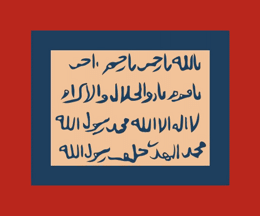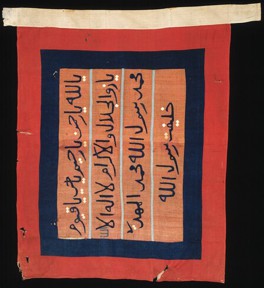 Image
by Esteban Rivera, 22 Apr 2024
Image
by Esteban Rivera, 22 Apr 2024based on photo

Last modified: 2025-04-12 by bruce berry
Keywords: sudan | mahdist state |
Links: FOTW homepage |
search |
disclaimer and copyright |
write us |
mirrors
 Image
located by Esteban Rivera, 22 Apr 2024
Image
located by Esteban Rivera, 22 Apr 2024
See also:
The Mahdist State, also known as Mahdist Sudan or the Sudanese Mahdiyya, was
a state based on a religious and political movement launched in 1881 by Muhammad
Ahmad bin Abdullah (later Muhammad al-Mahdi, as he declared himself "al-Mahdi,"
the Proclaimed One, successor to the prophet Mohammed) (also written Mohammed
Ahmed Ibn el-Sayyid Abdullah) (1844-1885) against the Khedivate (Viceroyalty) of
Egypt, which had ruled Sudan since 1821. Egypt was officially part of the
Ottoman Empire of Turkey, but its ruling khedives (viceroys) had a great deal of
autonomy and controlled the Sudan as a provincial colony.
Mohammed Ahmed
al-Mahdi enlisted the people of Sudan in what he declared a jihad against the
administration that was based in Khartoum, which was dominated by Egyptians and
Turks. The Khartoum government initially dismissed the Mahdi's revolution; he
defeated two expeditions sent to capture him in the course of a year. The
Mahdi's power increased, and his call spread throughout Sudan, with his movement
becoming known as the (al-) Ansar (or helpers, after the men of Medina who
supported the prophet Mohammed and were a diverse group--desert nomads, Nile
farmers, hill herders, soldiers who had been employed by slave traders and
former slaves from Central Africa) and currently are a Sufi religious movement
in the Sudan whose followers are disciples of Muhammad Ahmad, which
Umma claims to be its
rightful successor). During
the same period, in 1882 a nationalist-driven revolt, dubbed the 'Urabi
revolution broke out in Egypt, by the Egyptian army, which led the British to
intervene and assume control in Egypt to counter what they perceived as a threat
to the Suez Canal. England then found itself involved in an existing holy war in
the Sudan. Britain appointed Charles Gordon as General-Governor of Sudan. Months
after his arrival in Khartoum and after several battles with the Mahdi rebels,
Mahdist forces captured Khartoum, and Gordon was killed in his palace.
After four years of struggle, the Mahdist rebels overthrew the Ottoman-Egyptian
administration and established their own "Islamic and national" government with
its capital in Omdurman in 1885. Thus, from 1885 the Mahdist government
maintained sovereignty and control over the Sudanese territories. Soon after
taking the capital at Khartoum in 1885, the Mahdi fell ill and died suddenly.
Khalifa Abdullah Ibn Mohamed, leader of one of the army divisions, was declared
Khalifa al-Mahdi, the Madhi's successor and consolidated the new state, with
administrative and judiciary systems based on their interpretation of Islamic
(Sharia) law. The indigenous Nubian Coptic Christians who composed a substantial
portion of the country's population, were forced to convert to Islam.
The
British reconquered Sudan in 1898 by an Anglo-Egyptian force on September 2,
when the Battle of Omdurman took place. A year later the Battle of Umm
Diwaykarat took place on November 25, 1899 and marked the final defeat of the
Mahdist State in Sudan, when Anglo-Egyptian forces under the command of Lord
Kitchener defeated what was left of the Mahdist armies under the command of the
Abdallahi ibn Muhammad, known as the Khalifa, ruling it
after that in theory
as a condominium with Egypt but in practice as a colony. However, remnants of
the Mahdist State held out in Darfur until 1909, when Sanin Husain (c.
1847–1909) a religious and military leader who served the Mahdist State, refused
to surrender and continued to maintain a Mahdist holdout at Kabkabiya in Darfur,
reestablishing the Sultanate of Darfur, repeatedly defeating the armies of
Sultan Ali Dinar until he was finally killed by Ali Dinar's forces in a siege of
Kabkabiya lasting 17 to 18 months, in January.
The Mahdist State was a
proposed and unrecognized (Islamic) State.
While most of the known flags, tunics and weapons were taken on
the battlefield as military trophies during this last campaign, they were
originally created to convey specific religious principles as well as to unify
the diverse regional army that gathered around the Mahdi. These troops literally
rallied around flags proclaiming the word of God.
Sources:
https://www.si.edu/object/nmafa_91-20-1
https://www.britishmuseum.org/collection/term
https://www.si.edu/object/nmafa_91-20-1
https://en.wikipedia.org/wiki/Mahdist_State
https://en.wikipedia.org/wiki/Battle_of_Omdurman
https://en.wikipedia.org/wiki/Battle_of_Umm_Diwaykarat
https://en.wikipedia.org/wiki/Sanin_Husain and
https://en.wikipedia.org/wiki/Ansar_(Sudan)
The image shown at the top of this page is from the (U.S.) Smithsonian Museum (original located at https://www.si.edu/object/nmafa_91-20-1). The flags' appliquéd inscriptions are invocations of God's might and mercy, but with some variations in the closing line that lists leadership descent from God and the Prophet. Many flags were white with colored borders, the letters in different colors on one side. Allah, the name of God, is often emphasized with green, a color associated with Islam. It is possible that other colors referred to the military unit that owned the flag, but even contemporaneous accounts give contradictory identifications as to division colors. This example is particularly impressive because of its well-preserved state, vivid colors and the use of silk for the central panel. The white tube on the side would have slipped over the shaft of a spear when the banner was carried.
Description: Double sided rectangular cloth flag with a central brown silk
panel surrounded by a blue-black cotton border with an outer red cotton
border, and a white cotton tube for a pole support. The central panel
contains four lines of appliqued Arabic script in blue-black with white
diacritical marks and separated by pale blue lines. One word is appliqued in
green. It is made out of cotton and its dimensions are: H x W: 132.7 x 149.2
cm (52 1/4 x 58 3/4 in.) It was previously owned by Anthony Jack, London,
mid-1970s and Michael Graham-Stewart, London, 1991.
Esteban Rivera, 22 April 2024
 Image
by Esteban Rivera, 22 Apr 2024
Image
by Esteban Rivera, 22 Apr 2024
based on photo
Image based on the specimen located at the British Museum: https://www.britishmuseum.org/collection, https://ar.wikipedia.org/, source: https://ar.wikipedia.org/wiki
This flag belonged to the African part of the collection formed by the London
dealer William Ockelford Oldman in the years ca.1894-1926, purchased from his
widow, Dorothy Oldman, in 1949. Description: "Flag (with Arabic inscription);
sewn of cotton; rectangle of off-white cotton with blue appliqué Arabic writing;
red and blue borders around outside (belongs with the standard staff".
Dimensions: Length: Length: 112 centimetres , Width: Width: 135 centimetres.
Translation of text (attached to flag):
"God the compassionate, the merciful
The sole restorer of everything
There is no god but God and Mohamed is his
Prophet
Mohamed the Mahdi is the successor of the Prophet of God."
Esteban Rivera, 22 Apr 2024